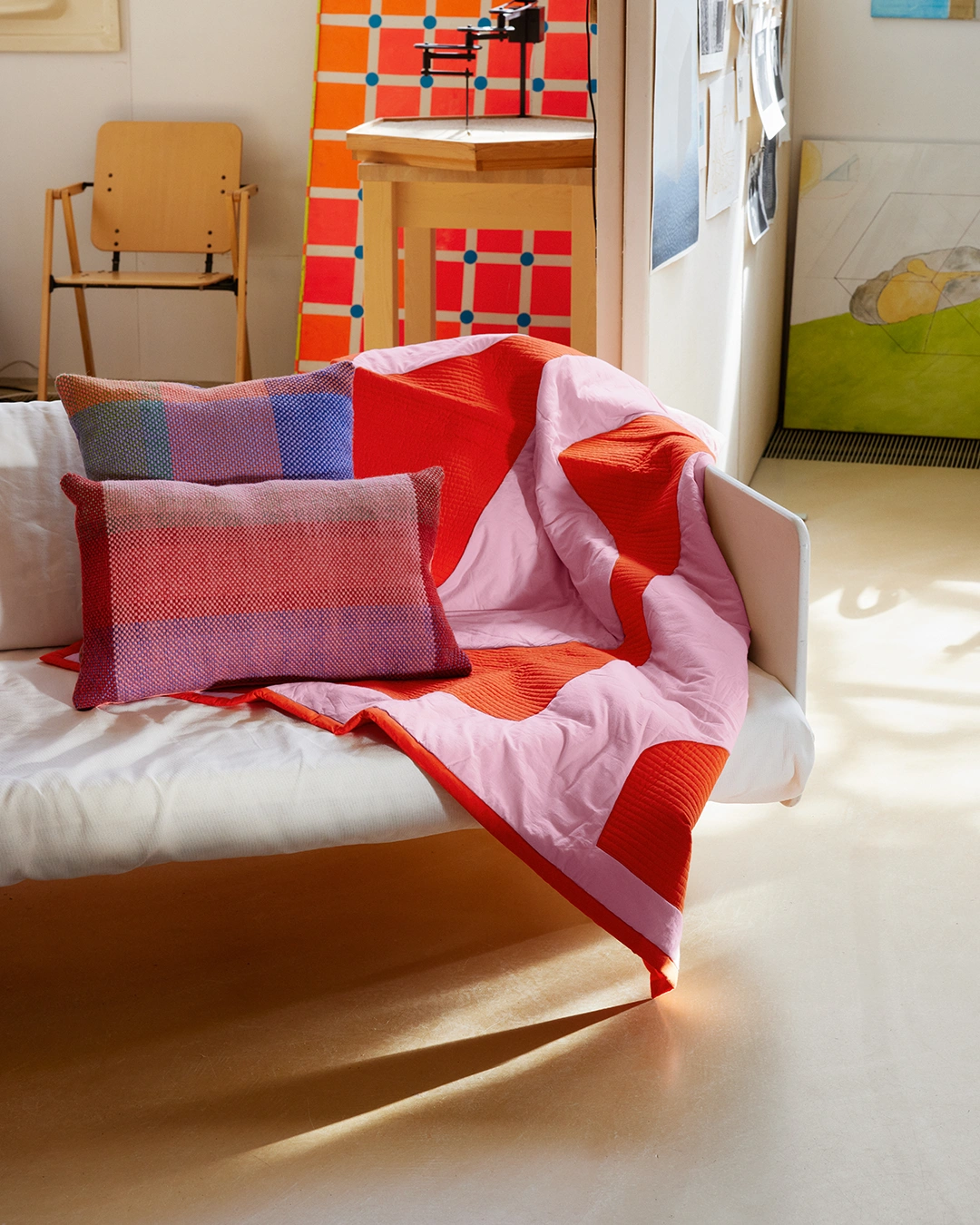Care Guide
Good maintenance extends the use and lifecycle of the product significantly.
We have created a guide on how to take care of your Finarte products. From here, you find both general and more material-specific care instructions that are easy to follow. If you are interested in properties of different materials and want to get tips on choosing the right material, see your Material Guide.
Cotton and cotton blend rugs

CARE
Cotton and cotton blend rugs are durable and practical, and with proper care, they can stay beautiful for a long time. Regular vacuuming helps to keep them clean, but it’s important to use a vacuum with low suction power, as modern vacuum cleaners can sometimes be too strong. This is especially true for plush cotton rugs, like the soft Dyyni, which are more delicate than tightly woven cotton rugs. When vacuuming, it’s best to use a nozzle designed specifically for rugs.
While traditional woven cotton rugs do not shed loose fibers, plush cotton rugs, such as Dyyni, may shed more fibers initially. This is completely natural and will reduce with use, though some shedding may continue over time—this is simply part of the charm of tufted rugs.
We do not recommend tamping or shaking rugs, as these can damage the structure of handmade products.
While cotton may not repel dirt like wool, it’s easy to clean with water. Stains can be gently removed by blotting with a damp cloth and mild detergent. Remember to avoid scrubbing to keep the fibers in good condition.
WASHING
We recommend a gentle hand wash or flat wash at 30 degrees Celsius (80°F) for Finarte cotton rugs. Machine washing or the use of a pressure washer is not permitted. When washing the rug yourself, please use a mild detergent and avoid soaking the rug. Wash the striped rugs in line with the stripes, and rinse the rug thoroughly. Dry the cotton rug in a shady place on a flat surface or hang it to dry so that the water drains along the stripes. A wet rug should not be rolled or folded.
For more detailed tips on washing cotton rugs yourself, you can read our guide here. Although our tips are tailored for washing rugs outdoors, you can also apply these instructions for washing rugs indoors. Please consider the environment and wash the rugs in a location where the washing water does not directly enter the water system. For larger cotton rugs, we always recommend professional cleaning, as they can be very heavy when wet, making them difficult to handle and dry.
You can also wash your rugs in clean snow during winter. Find our tips for snow washing rugs here.
Wool rugs
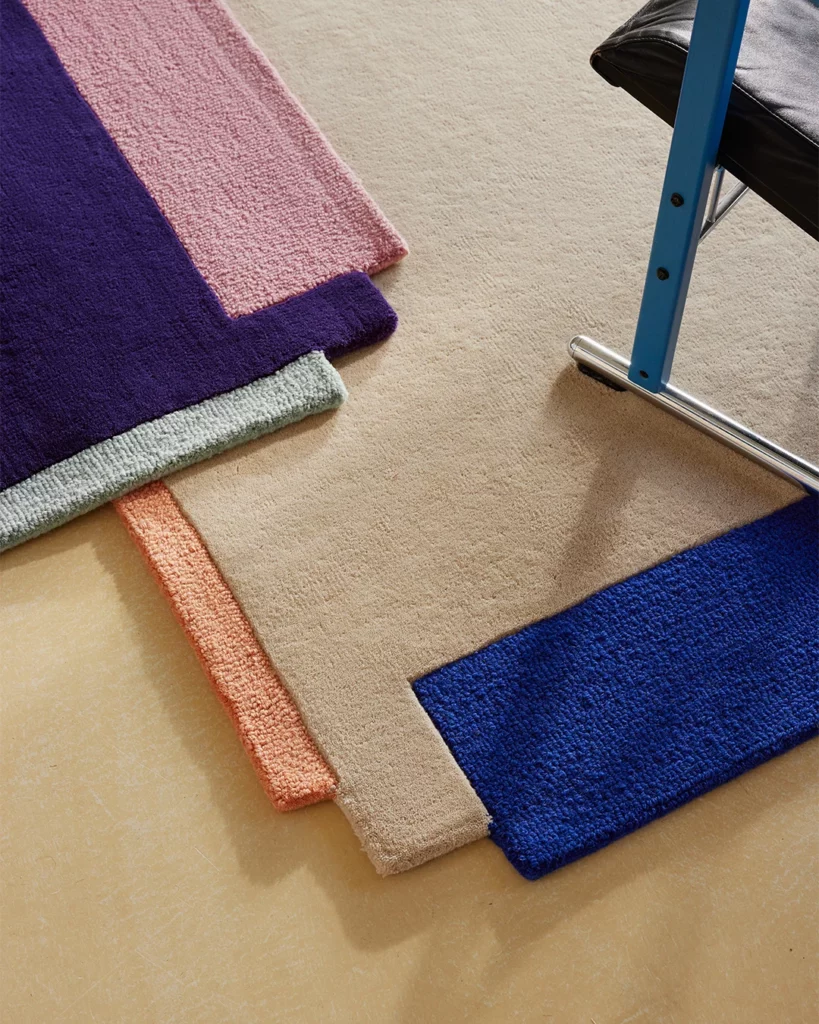
CARE
Wool is a relatively easy-care rug material. The most effective and important way to maintain a wool rug is through regular vacuuming. If dirt and dust are not removed, they can damage the rug’s structure over time. Use a V-shaped motion when vacuuming a flat, tightly woven wool rug. For long-pile and tufted wool rugs, we recommend using a lower suction power, as excessive force can loosen the structure of these rugs and detach the fibers. Occasionally, use a vacuum nozzle to carefully go over the long-pile wool rug to remove loose dust between the fibers.
It is normal for a new wool rug to shed some fluff, as this is typical for natural materials like wool. Note that tightly woven wool rugs tend to shed fewer fibers compared to longer-pile hand-knotted and tufted rugs. Tufted and hand-knotted rugs shed more fibers due to the techniques used in their construction, especially initially, but this will decrease over time. However, some shedding will always occur to some extent, and this is a natural characteristic of wool.
To freshen up your wool rug, take it outdoors. However, we do not recommend tamping or shaking rugs, as this can damage the handwoven surface. Regular vacuuming is preferred to effectively remove dust and loose dirt from the rug.
STAINS
Wool naturally repels water and dirt. If a liquid spills on a wool rug, it will not be immediately absorbed into the fibers and will remain on the surface. However, it’s important to act quickly when removing stains. First, remove any solid debris, and then soak up the liquid with a clean cloth or paper towel. If the stain has been absorbed into the rug, gently press a damp, lint-free cloth with a small amount of mild detergent suitable for wool onto the stain. Avoid rubbing the stain or using excessive soap, as soft wool can easily felt.
WASHING
We recommend having wool rugs professionally dry cleaned. In winter, you can also wash your wool rug with snow. Read our tips on that here.
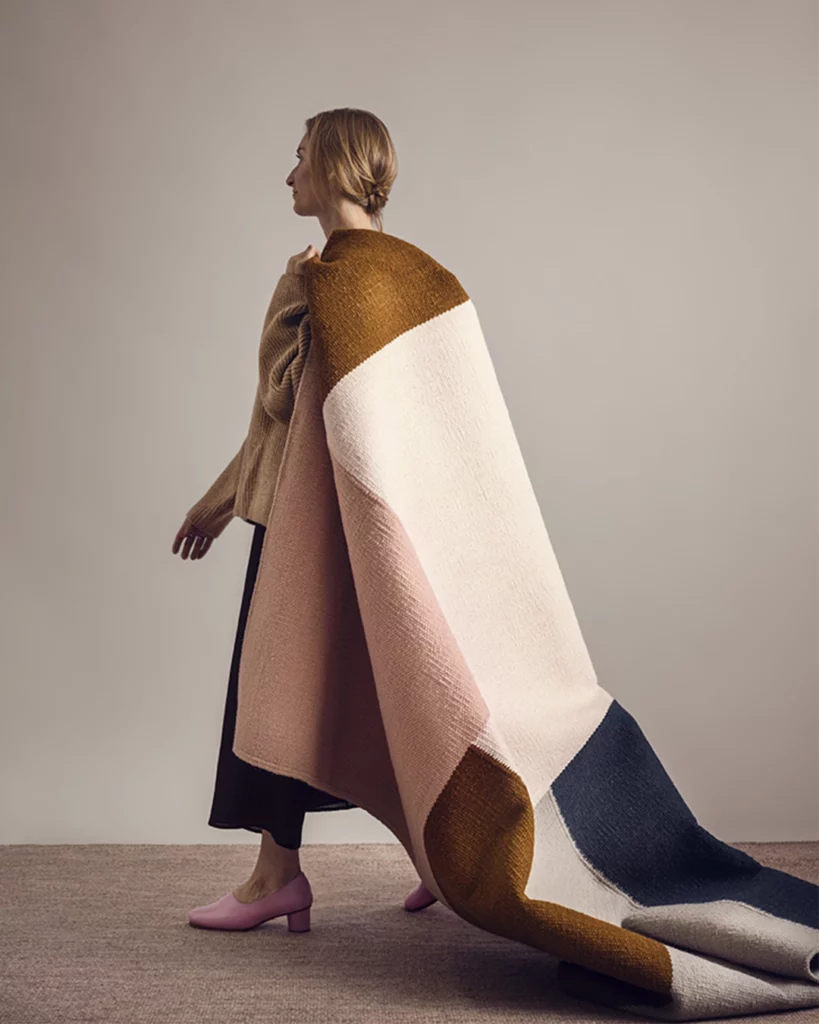
Viscose rugs
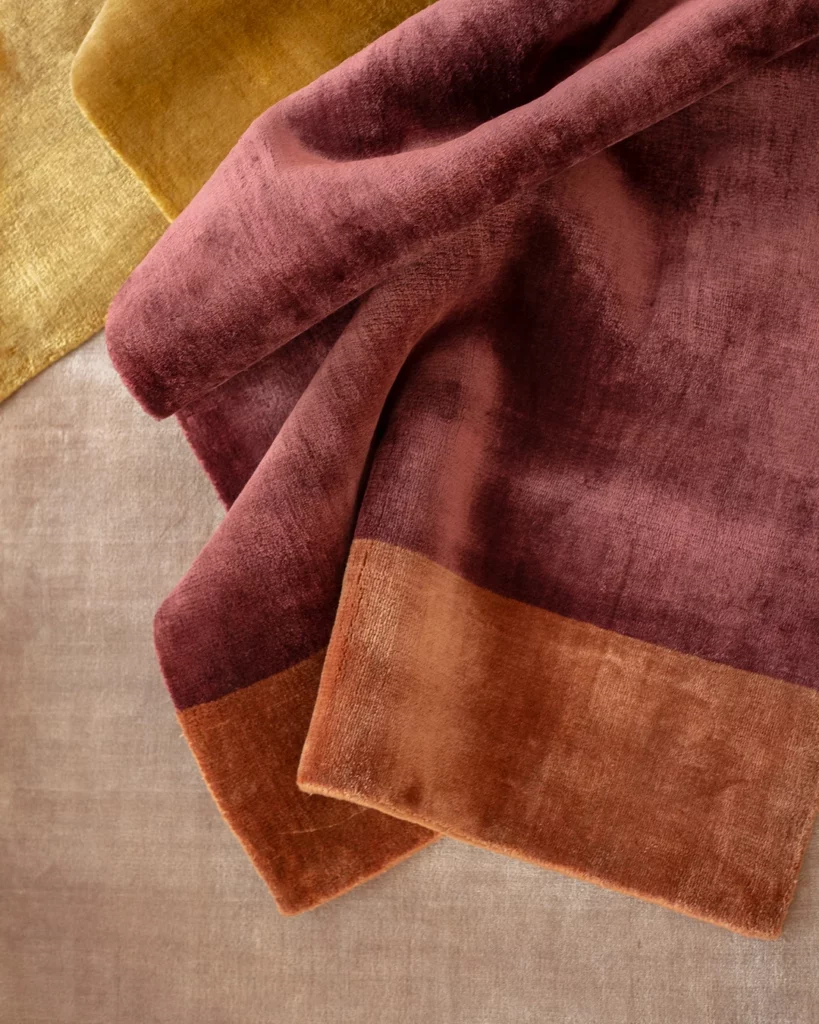
CARE
Viscose is a more sensitive material than wool or cotton. However, when properly cared for, a beautiful shining viscose rug is a long-lasting purchase. Use a protection spray for your new viscose rug before use. The protection spay prevents dirt from being absorbed into the viscose fibers and makes the maintenance of the rug easier. Vacuum the viscose rug regularly in the direction of the lint.
Some fluff can come off from a new viscose rug, but it evens out over time. You can remove the fluffy fibers by vacuuming or lightly brushing. The surface of the viscose rug may make you want to vacuum it often and with full power, but this should be avoided. Instead, use lower power of suction and also give your rug time to rest. An intense, repetitive rubbing motion can open the thread ends of the viscose rug, causing the beautiful shine of the rug’s surface to disappear.
STAINS
Viscose fiber absorbs moisture quickly, so you should be quick to remove stains. To remove stains, use a soft, lint-free cleaning cloth and remove the stain from its edges by moving it to the center to prevent spreading it. Avoid strong detergents and rubbing. When removing stains, it is also worth noting that viscose is sensitive to water, and water can cause stains on the surface of the viscose rug.
WASHING
For viscose rugs, we recommend professional dry cleaning.
Jute rugs
CARE
The easiest way to keep a jute rug tidy is to vacuum regularly. Some fiber can come off the new jute rug, which is a normal feature of a jute rug.
The edges of the jute rug can sometimes curl. To smooth the rug, lightly dampen the curled area with water and place something flat and heavy on it, such as books. Let the weights stay in place overnight.
STAINS
On the naturally multicolored surface of the jute rug, dirt is hardly visible. Finarte jute rugs are woven tightly, so loose dirt often stays on the surface of the rug and is easy to vacuum away. You can clean stains by gently rubbing them with a damp cloth.
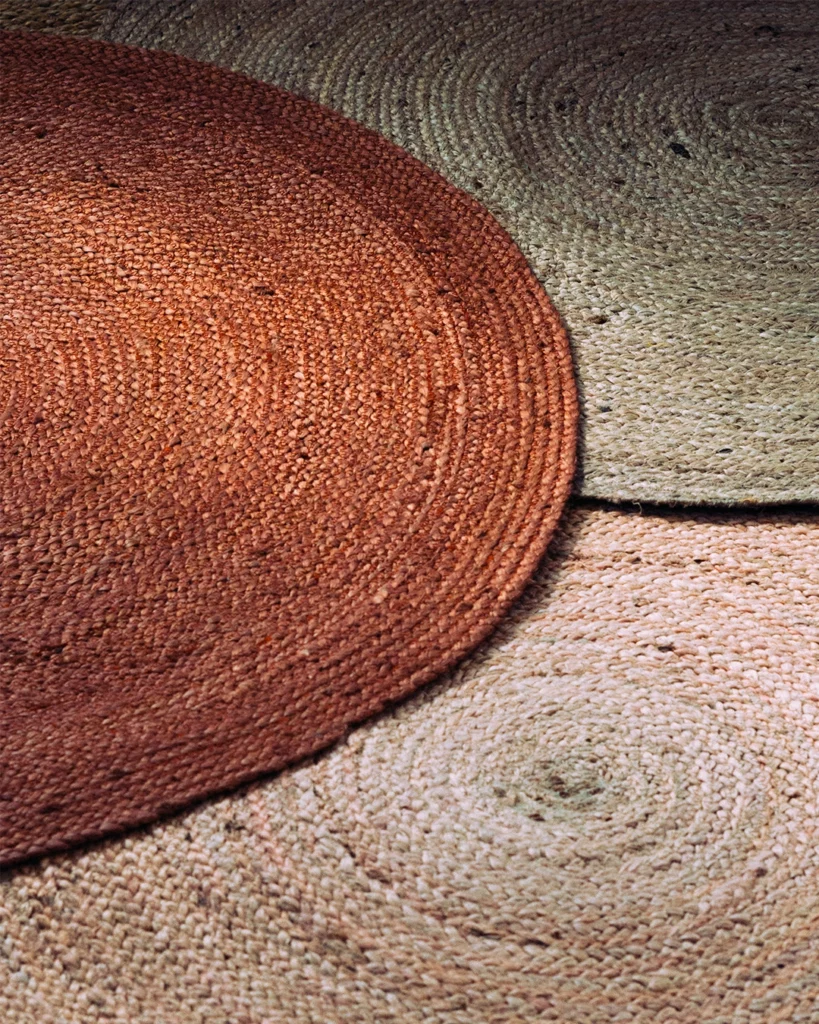
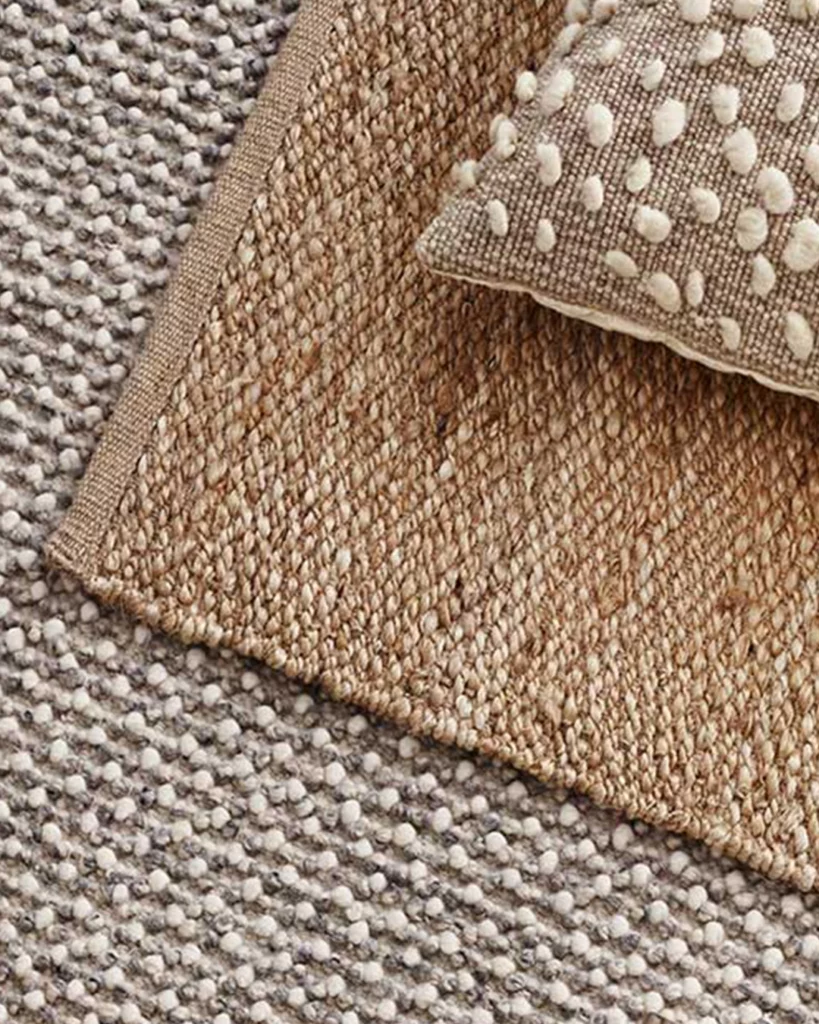
WASHING
We recommend dry cleaning the jute rugs with professional cleaning, but you can also wash a small jute rug yourself. Find our tips on rug washing from here. Although these tips are written for washing rugs outdoors, you can also use them for washing rugs indoors. Take the environment into account in rug washing, and don’t wash your rugs in places where the washing water enters the water system directly.
Please note that water may leave marks on the jute rug when washing it. Avoid soaking the rug and rinse it thoroughly. Dry the jute rug quickly after washing because being wet for a long time can affect the shape of the jute rug. Spread the rug on a flat surface and air dry in a shady place. Wet rug must not be folded or rolled. Wait that the rug is completely dry before using it.
Rpet rugs
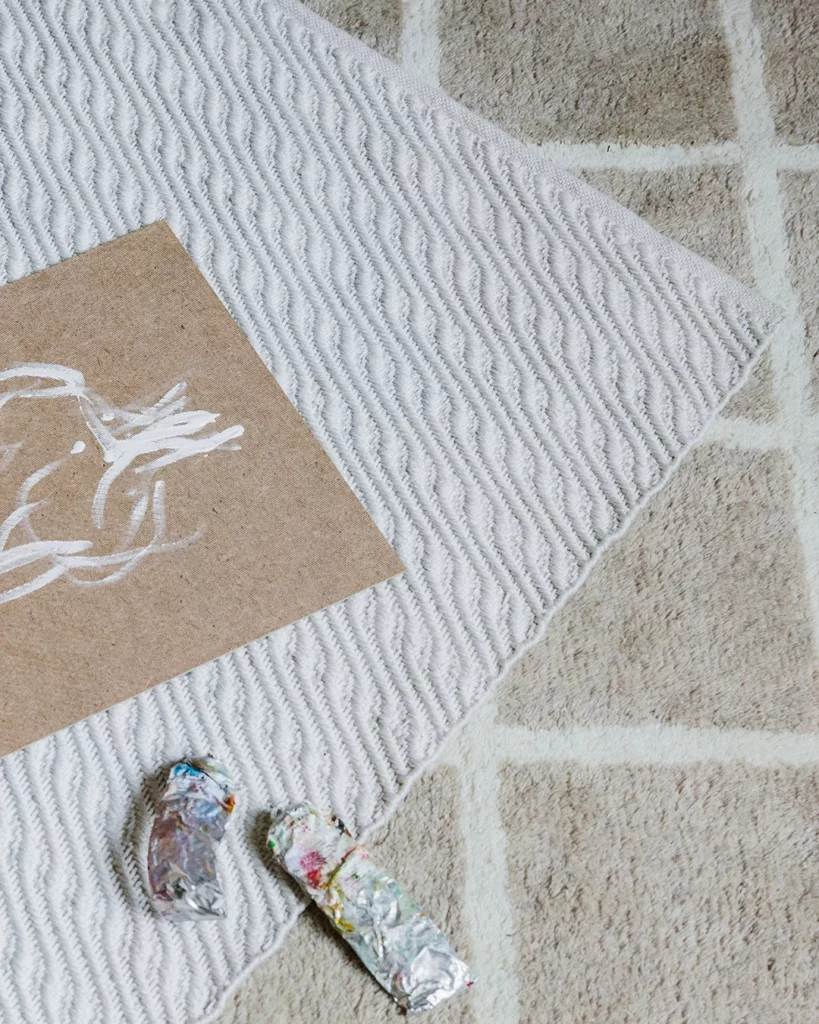
CARE
rPET rugs, made from recycled plastic bottles, are easy to care for and practical. Vacuum the rug regularly on both sides to prevent loose dirt from adhering to the rug’s structure. rPET rugs might collect more dust than natural fiber rugs due to their electrostatic charge. However, liquid dirt does not stick to the rug as water cannot enter the structure of the fiber. Do not tamp or shake the rug at its ends, as this may damage the rug.
STAINS
If there is a stain on the rPET rug, remove first the liquid dirt by pressing with a clean cleaning cloth. Avoid rubbing as it may damage the surface of the rug. Clean the stain by pressing it again with a cleaning cloth or sponge. Use a mild detergent diluted in water for cleaning. When the stain has come off, rinse off the detergent. Wait that the rug is completely dry before using it.
WASHING
For washing rPET rugs, we recommend a gentle hand wash at 30 degrees (80F) or a flat wash in professional cleaning. Machine washing and washing with a pressure washer are prohibited. Like ordinary polyester, recycled polyester releases microplastic when washing, so please take this into account when washing the rug.
Accessories
By taking good care of your home accessories, you will have long-lasting partners for your home. We always recommend local stain cleaning for home accessories. You can use a damp cloth and, if necessary, a mild cleaning agent suitable for the material to remove the local stains. However, if the product requires complete washing, you can get it clean using the tips below.
AITTA- JA KIEVARI-PRODUCTS MADE FROM COTTON
Aitta and Kievari products, made from recycled cotton, can be washed in a gentle wash of 30 degrees (80F). Shape the product to its original dimensions when moist and, if necessary, iron with low heat on the backside. Please note that the pattern is printed and may fade over time during washing.
WOOL CUSHION COVERS
Our wool embroidered pillowcases, such as Terttu, Zeniitti, and Silmu, can be washed upside down in a gentle wash of 20 degrees (65F) with a detergent suitable for wool. Do not tumble dry. Note that as the material on the front is wool and the material on the back is cotton or linen (in Väre cushion cover), the different sides may shrink differently during washing, and you have to shape the product back to its original dimensions when moist. If necessary, iron on the backside with low heat.
VÄRE THROW MADE FROM WOOL
You can refresh the woolen Väre throw by airing it outdoors in the wintertime. However, you can also wash the throw in a gentle 30 degree (80F) wash with a detergent suitable for wool. Do not tumble dry. Shape the product back to its original dimensions when moist.
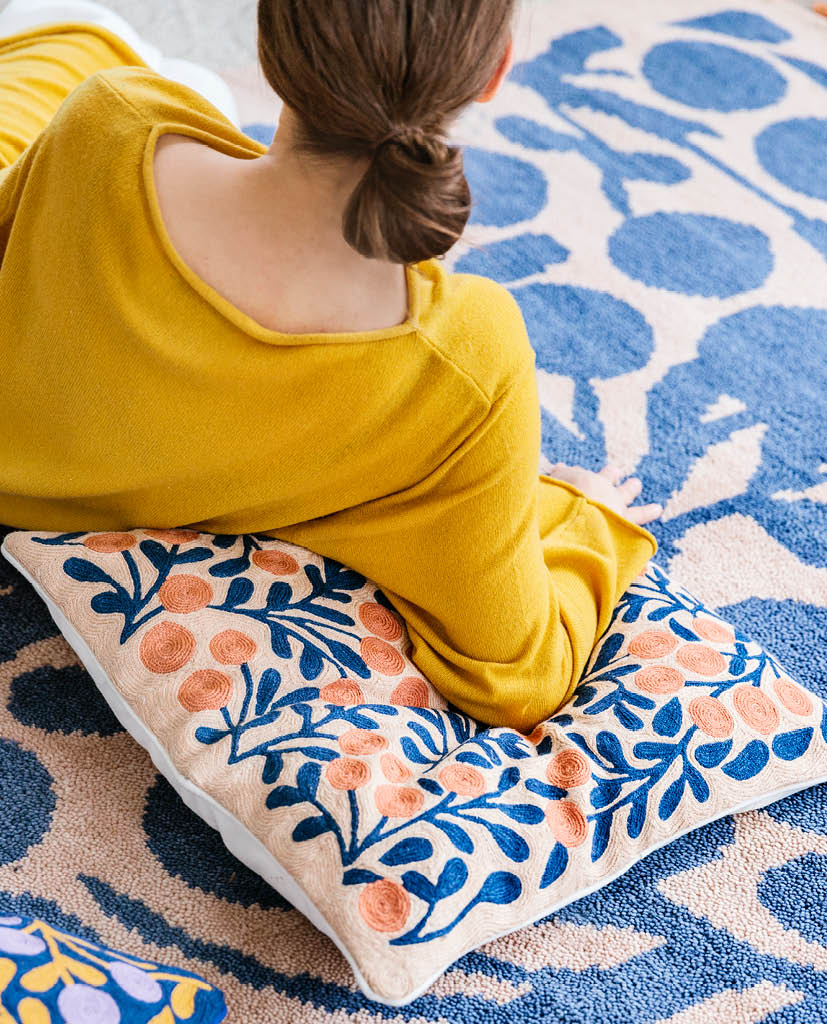
General tips
DON’T WASH IF NOT NECESSARY
Start always with local stain removal if possible, and only wash your rugs if this doesn’t help. Keep an eye on the condition of your rug and take care of it by vacuuming and airing it. Only wash your rug when it is dirty, as each wash consumes it. Please always wash your rug within the instruction of the specific rug has. You will find the washing symbols used in Finarte rugs with their meanings a little lower on this page.
PROTECT WITH SPRAY
Protect your rug with a separate protective spray, which prevents dirt from sticking to the fibers and surface of the rug. The spray reduces the need to wash the rug and helps with cleaning the local stains. You can find a textile protection spray suitable for our rugs here.
TAKE SUNLIGHT INTO ACCOUNT
Turn your rugs lengthwise from time to time, especially if they are in a very sunny spot in the apartment. Sunlight can fade the color of natural fiber rugs. By turning the rug, it gets light more evenly.
AIR OUTSIDE
Airing your rug from time to time will keep it fresh and odor-free. Especially in the winter, the frosty air refreshes textiles well and even removes dust mites.
PAY ATTENTION TO HEAVY FURNITURE
Heavy furniture can cause dents on the surface of the rug. To avoid dents, change the positions of heavy furniture from time to time or turn the rug under to a different way.
USE UNDERLAYS
If the rug feels slippery with your floor material, we recommend placing an underlay underneath it. You can find our underlays from here. Also, wash the underlay from time to time with lukewarm water and mild detergent to prevent it from losing its functionality due to dust.
TAKE CARE OF THE FRINGES
The fringe at the ends of a hand-woven rug can loosen or even open over time. Keep an eye on the condition of the fringes, as they keep the entire structure of the rug together. A common cause of fringe loosening is to vacuum them with too strong suction power, so avoid strong vacuuming of fringes. Office chairs and other wheeled furniture can also loosen fringes, so avoid placing them on top of the rug’s fringes. If the fringes on your rug have got a knot open, try to tie it in the same way as the other fringes on the rug. The most common knots used in carpet fringes are the overhand knot and the reef knot.
TURN FROM TIME TO TIME
Turn the rug on the floor lengthwise from time to time so that its consumption is more even. Some of our rugs are also double-sided, so turning around the entire rug and using both sides will double the life of your rug.
DON’T TAMP
We do not recommend tamping as it can damage hand-woven rugs. Instead, remove dust and loose dirt by vacuuming the rug regularly.
AVOID ROBOTIC VACUUM CLEANER
We do not recommend robotic vacuum cleaners for rug vacuuming. Robotic vacuum cleaners can be rough to your rugs and damage the surface of the rug as well as fringes when vacuuming.
STORE PROPERLY
Sometimes the rug needs to be stored for a shorter or longer time. Then wrap a clean rug in a clean roll to avoid wrinkles and creases. Tie the roll with a few ribbons. You can wrap the rug in a paper if the storage is long-term. Store the rolled rug horizontally in a dry and cool, preferably bright, warehouse. In particular, wool and viscose rugs are sensitive to pests such as moth larvae and fur beetles, which thrive best in humid, dark, and warm. Do not place anything heavy on the stored rug because it may leave dents on the rug.
Wash symbols
HAND WASH

The symbol of hand washing the carpet is a brush held by the hand. If the rug has this symbol, you can also wash the rug by yourself. The rug has to be flat washed. Please take the environment into account and wash the rugs in a place where the washing water does not get directly into the waterways. A check above the symbol prohibits hand washing, and a bar under the symbol means gentle hand washing.
TUMBLE WASH

The symbol for drum cleaning is a washing tub with the letter “M” inside, which signifies carpet drum cleaning. Drum cleaning is performed in the laundry’s carpet washing machine using water and detergent. A cross over the washing tub prohibits drum cleaning, while a line beneath the symbol indicates gentle drum cleaning.
FLAT WASHING

The symbol for flat washing a rug is a washing brush. Flat washing refers to a water-based cleaning process done in a laundromat using a flat washing machine, where the rug is laid out flat in a horizontal position. During the wash, the rug is soaked, diluted detergent is applied, the rug is brushed, rinsed, and the excess water is squeezed out using a roller press. A bar under the symbol indicates that a gentle flat washing process should be used.
TUMBLE DRYING

The symbol for drum drying is a square with a circle inside. A cross over the symbol, as shown in this image, indicates that drum drying is prohibited. If there are dots inside the symbol instead of a cross, they indicate the maximum drying temperature allowed.
CHEMICAL WASH

The symbol for chemical cleaning is a circle containing a letter. Different letters indicate the solvents used in the cleaning process. In chemical cleaning, the rug is cleaned without water in a professional laundry using organic solvents. A line beneath the symbol, as shown in this image, indicates gentle chemical cleaning, while a cross over the symbol prohibits chemical cleaning.
Care and maintenance products


